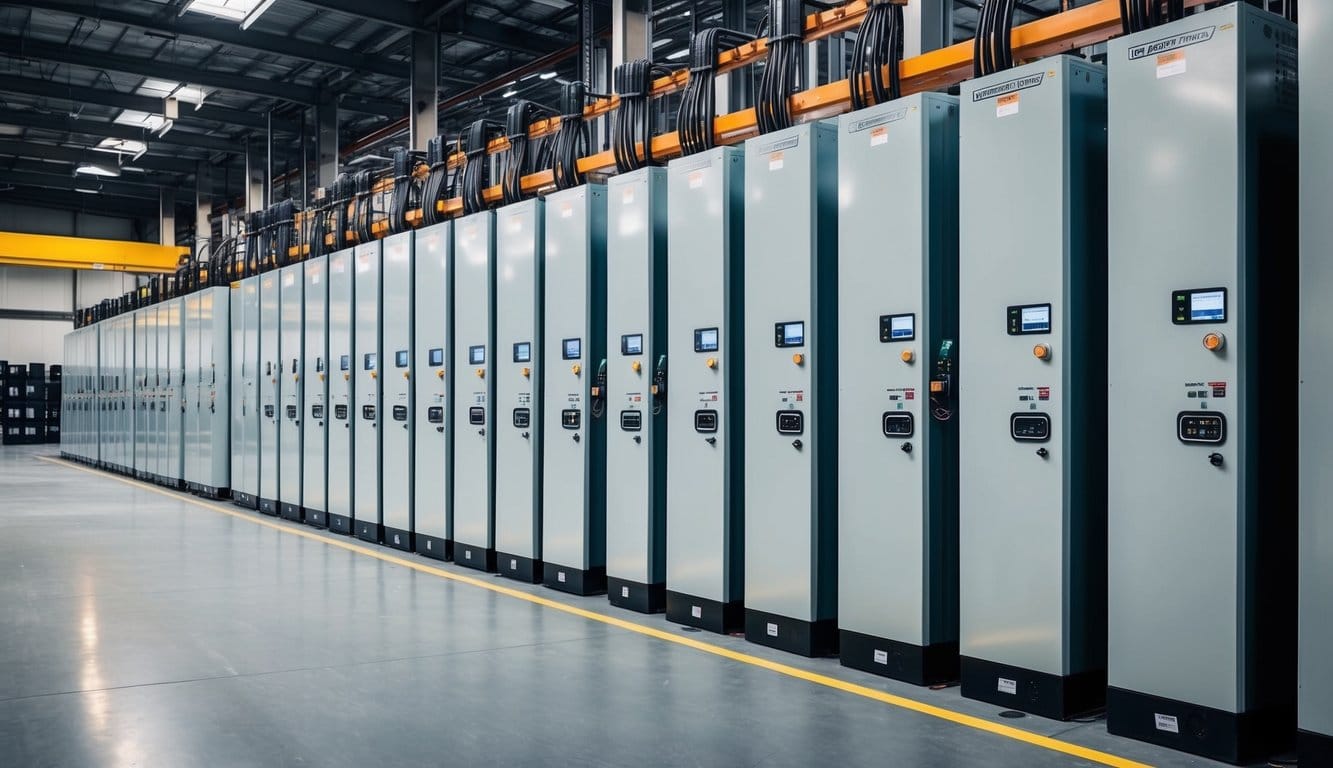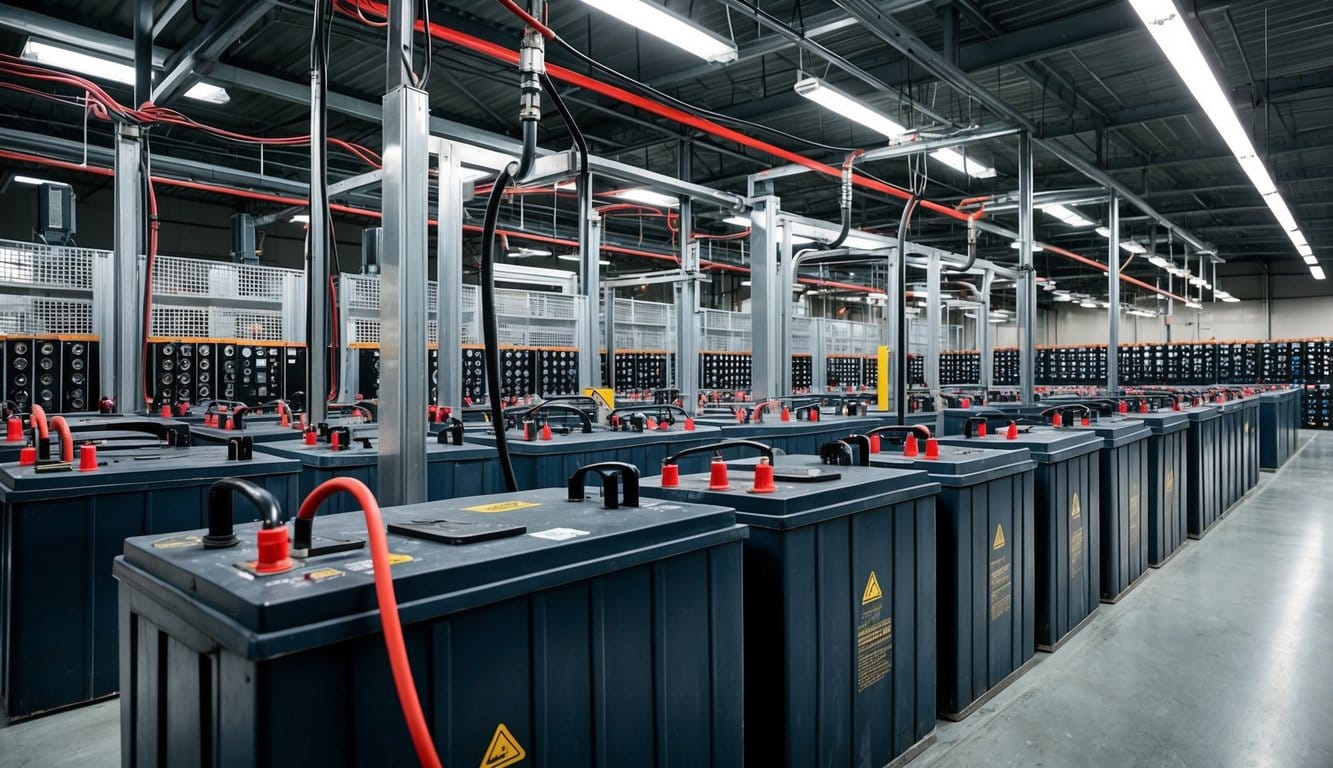Commercial Battery Storage: Powering the Future of Business Energy Management
Commercial battery storage systems allow businesses to store energy from solar panels or the grid for later use. These systems can reduce energy costs, provide backup power, and help companies become more sustainable. They work by storing excess electricity in batteries during off-peak times when rates are lower. The stored power can then be used during peak hours when electricity is more expensive.
You can choose from different types of commercial battery storage solutions. Some systems use lithium-ion batteries, while others use flow batteries or other technologies. The right option depends on your company’s needs, budget, and goals. Many businesses pair battery storage with solar panels to maximise savings and energy independence.
Battery storage offers several benefits for commercial sites. It can smooth out power supply, protect against outages, and lower demand charges. You can also use stored energy to avoid high time-of-use rates. As battery costs keep falling, more firms are adding storage to cut bills and boost sustainability.

Understanding Commercial Battery Storage Systems
Commercial battery storage systems are crucial for managing energy in businesses and industries. These systems store electricity for later use, helping companies save money and reduce their reliance on the grid.
What Is Commercial Battery Storage?
Commercial battery storage is a system that stores electrical energy for later use in business settings. It allows companies to capture excess power during low-demand periods and use it when needed. These systems come in various sizes, from small units for shops to large installations for factories.
Battery storage helps businesses:
- Cut energy costs
- Improve power quality
- Back up critical systems
- Support renewable energy use
Many firms now see battery storage as a key part of their energy strategy. It offers a way to manage power more efficiently and sustainably.
How Do Commercial Battery Storage Systems Work?
Commercial battery storage systems work by charging, storing, and discharging electricity. Here’s a simple breakdown:
- Charging: The system takes in power from the grid or on-site sources like solar panels.
- Storing: Energy is kept in batteries until needed.
- Discharging: Stored power is released when demand is high or grid supply is low.
These systems use smart controls to decide when to charge or discharge. They can respond quickly to changes in power needs or grid conditions. This helps businesses avoid peak pricing and maintain steady power supply.
Key Components of Battery Storage Systems
Commercial battery storage systems have several important parts:
- Batteries: Store the electrical energy
- Inverters: Convert DC power from batteries to AC for use
- Battery Management System: Monitors and controls the batteries
- Energy Management System: Optimises overall system performance
- Cooling System: Keeps batteries at the right temperature
The type and size of these components vary based on the system’s needs. Lithium-ion batteries are common due to their high energy density and long life. Some systems use other types like flow batteries for specific applications.
Proper design and integration of these parts is vital for a system to work well. Regular upkeep ensures the system stays efficient and safe over time.

Benefits of Commercial Battery Storage
Commercial battery storage systems offer businesses significant advantages in energy management and cost reduction. These systems provide essential tools for optimising power usage and increasing sustainability.
Cost Reduction Through Peak Shaving
Battery storage enables firms to cut electricity costs through peak shaving. This method involves charging batteries when rates are low and using stored energy during peak demand periods. By reducing reliance on the grid at expensive times, companies can lower their energy bills substantially.
Peak shaving also helps avoid costly demand charges. These fees are based on a business’s highest energy use during a billing cycle. With battery storage, firms can draw from their reserves instead of the grid during high-demand times, keeping their peak usage lower.
Some utilities offer time-of-use rates with cheaper off-peak prices. Battery systems let businesses take full advantage of these tariffs by shifting energy consumption to less expensive hours.
Energy Independence and Reliability
Battery storage boosts energy independence and reliability for businesses. These systems act as backup power sources during outages, keeping critical operations running smoothly.
For companies with on-site renewable energy, batteries enhance self-sufficiency. They store excess solar or wind power for use when needed, reducing reliance on the grid. This approach maximises the value of renewable investments and increases energy security.
Battery storage also helps smooth out power fluctuations. It can quickly respond to changes in supply or demand, maintaining a stable electricity flow. This feature is crucial for businesses with sensitive equipment or processes that require consistent power.
Grid Support Capabilities
Commercial battery systems can provide valuable services to the electrical grid. These include frequency regulation, voltage support, and load balancing.
By participating in grid services, businesses can earn extra income. Many utilities offer programmes that pay for battery capacity used to stabilise the grid. This creates a new revenue stream for companies with battery storage.
Grid support also helps integrate more renewable energy into the power system. Batteries can store excess renewable power and release it when needed, making the grid more flexible and resilient.
Environmental Impact
Battery storage supports environmental goals by enabling greater use of renewable energy. It addresses the intermittent nature of solar and wind power, making these sources more reliable and easier to integrate into business operations.
By reducing reliance on fossil fuel-based grid power, battery systems help lower carbon emissions. This is particularly effective when combined with on-site renewables, creating a cleaner energy mix for the business.
Energy storage also improves overall grid efficiency. It can reduce the need for polluting peaker plants, which are only used during high demand periods. This leads to a cleaner power system for everyone.

Types of Commercial Battery Storage Technologies
Commercial battery storage systems use various technologies to store and distribute energy. Each type has unique characteristics suited for different applications and needs.
Lithium-Ion Batteries
Lithium-ion batteries are the most common choice for commercial energy storage. They offer high energy density, making them compact and lightweight. These batteries have a long cycle life and can handle frequent charging and discharging.
Lithium-ion batteries are versatile. They work well for both short-term and long-term energy storage needs. Many businesses use them for peak shaving to reduce electricity costs during high-demand periods.
One drawback is their higher upfront cost compared to some other options. However, their efficiency and longevity often make them cost-effective in the long run.
Flow Batteries
Flow batteries store energy in liquid electrolytes held in separate tanks. This design allows for easy scaling by simply increasing tank size. They have a long lifespan and can handle deep discharges without damage.
These batteries are ideal for large-scale, long-duration storage. They’re often used in grid-level applications and renewable energy integration.
Flow batteries have lower energy density than lithium-ion, so they need more space. They also have higher upfront costs, but their long life and low maintenance needs can offset this over time.
Lead-Acid Batteries
Lead-acid batteries are an older technology but still used in some commercial applications. They’re cheaper upfront than newer options, making them attractive for budget-conscious projects.
These batteries are reliable and can provide high surge currents. This makes them suitable for backup power systems and UPS applications.
Lead-acid batteries have shorter lifespans and lower energy density compared to lithium-ion. They also require more maintenance and have environmental concerns due to their lead content.
Emerging Storage Technologies
New battery technologies are being developed to address current limitations. Solid-state batteries promise higher energy density and improved safety over liquid electrolyte batteries.
Sodium-ion batteries are another promising option. They use more abundant materials than lithium-ion, potentially reducing costs.
Zinc-air batteries are being explored for their high energy density and use of inexpensive materials. However, these technologies are still in early stages and not yet widely available for commercial use.

Implementation and Integration
Implementing and integrating commercial battery storage systems requires careful planning and execution. The process involves several key steps to ensure optimal performance and compliance with regulations.
Site Assessment Requirements
Site assessment is crucial for successful battery storage implementation. You need to evaluate the physical space, electrical infrastructure, and environmental conditions. Check for adequate ventilation and temperature control to maintain battery health. Assess the existing electrical system’s capacity and compatibility with the proposed storage solution.
Consider safety requirements, including fire suppression systems and proper containment measures. Evaluate potential noise impacts on surrounding areas. Conduct a thorough analysis of the site’s energy usage patterns and peak demand to determine optimal battery sizing.
Review local zoning laws and building codes to ensure compliance. Obtain necessary permits and approvals before proceeding with installation.
Installation Process
The installation process begins with site preparation. Clear the designated area and make any necessary modifications to accommodate the battery system. Install proper foundations or mounting structures to support the weight of the batteries and associated equipment.
Next, place the battery modules and connect them according to the manufacturer’s specifications. Install the power conversion system, which includes inverters and controllers. Set up the battery management system to monitor and control the storage unit’s operation.
Connect the battery system to the existing electrical infrastructure. This may involve upgrading the main distribution panel or installing a dedicated circuit. Implement safety features such as emergency shut-off switches and warning signs.
After installation, conduct thorough testing and commissioning to verify proper functionality and safety.
System Sizing Considerations
Proper system sizing is essential for maximising the benefits of commercial battery storage. Analyse your energy consumption patterns, focusing on peak demand periods and daily load profiles. Consider future growth projections and potential changes in energy usage.
Calculate the required energy capacity based on your specific goals, such as peak shaving or backup power duration. Factor in the battery’s depth of discharge and cycle life to ensure longevity.
Evaluate the power rating needed to meet your peak demand reduction targets. Consider the battery’s charge and discharge rates to match your operational requirements.
Balance system size with budget constraints and available space. Oversizing can lead to unnecessary costs, while undersizing may limit the system’s effectiveness.
Grid Connection Requirements
Connecting your battery storage system to the grid involves meeting specific technical and regulatory standards. Consult with your local utility company to understand their interconnection requirements and procedures.
Comply with grid codes and standards for power quality, voltage regulation, and frequency response. Install appropriate metering equipment to measure energy flows between your system and the grid.
Implement protection systems to prevent backfeeding during power outages and ensure safe isolation from the grid when needed. Configure your system to operate within allowed export limits and respond to utility signals for demand response programmes.
Obtain necessary approvals and certifications from the utility and relevant authorities before energising the system. Schedule inspections and testing to verify compliance with grid connection requirements.
Commercial Applications and Use Cases
Commercial battery storage systems help businesses manage energy costs and improve efficiency. These systems offer flexibility and reliability across various sectors.
Industrial Facilities
Industrial sites use battery storage to smooth out power demand and reduce peak energy costs. Large factories often pair batteries with solar panels to maximise renewable energy use. This combo lets them store excess solar power during the day and use it at night or during high-demand periods.
Battery systems also provide backup power for critical machinery. This keeps production lines running during short outages. Some facilities use batteries to participate in grid services, earning money by feeding power back to the grid when needed.
Electric vehicle charging stations at industrial sites can benefit from battery storage too. Batteries help manage the load from multiple vehicles charging at once.
Office Buildings
Office buildings use battery storage to cut electricity bills and boost sustainability. Batteries store cheap off-peak power for use during expensive peak hours. This process, called load shifting, can lead to big savings.
Many offices link batteries to rooftop solar panels. This setup allows them to use more of their own clean energy and rely less on grid power. During power cuts, battery systems can keep essential services running, like lifts, lighting, and IT systems.
Smart building management systems often control these batteries. They can predict energy use and adjust battery charge/discharge cycles for best results.
Retail Centres
Retail centres face high energy costs due to long operating hours and heavy use of lighting and air con. Battery storage helps them manage these costs and improve energy security.
Batteries paired with solar panels can power shops during the day and store excess energy for evening use. This reduces reliance on expensive grid power during peak shopping times.
Many retail sites use batteries to avoid demand charges. These are fees based on a site’s highest power use. By using stored energy during high-demand periods, shops can lower these charges.
Battery systems also provide backup power for till systems, security cameras, and emergency lighting during outages.
Data Centres
Data centres need constant, high-quality power to keep servers running. Battery storage systems play a key role in ensuring this reliability.
Large battery arrays act as uninterruptible power supplies (UPS) for data centres. They provide instant backup power if the main supply fails, bridging the gap until generators start up.
Some data centres use batteries for more than just backup. They can help smooth out power fluctuations and improve overall energy quality. This protects sensitive equipment from damage.
Batteries also let data centres take part in demand response programs. These schemes pay businesses to reduce power use during grid stress. Data centres can switch to battery power briefly, earning money while maintaining operations.
Cost Analysis and ROI
Commercial battery storage costs and returns depend on several factors. Understanding these elements helps businesses make informed decisions about implementing energy storage systems.
Initial Investment Considerations
The upfront cost of a commercial battery storage system is a key factor. Lithium-ion batteries, commonly used for energy storage, cost about £105 per kWh. A typical system’s price ranges from £320,000 to £560,000 per megawatt.
System size affects costs significantly. Larger systems often have lower per-unit costs due to economies of scale. Location also plays a role, with installation expenses varying by region.
Equipment quality impacts both initial outlay and long-term performance. Higher-grade components may cost more upfront but can lead to better efficiency and longevity.
Operational Costs
Ongoing expenses for battery storage systems are generally low. Maintenance needs are minimal, with routine check-ups being the main requirement. Modern systems often include features that optimise battery life and reduce wear.
Energy losses during charging and discharging cycles contribute to operational costs. Efficiency rates typically range from 80% to 90%.
Replacement costs should be factored in, as batteries have a finite lifespan. Most systems last 10-15 years before needing replacement.
Expected Returns
Returns from battery storage come mainly through energy arbitrage and demand charge reduction. Energy arbitrage involves buying electricity when prices are low and selling when high.
Demand charge reduction can lead to significant savings. By using stored energy during peak demand periods, businesses can avoid high tariffs.
The capacity factor, which measures how often the system is used, affects returns. Higher usage generally leads to better ROI.
Payback periods vary but often range from 5 to 10 years, depending on system use and local energy prices.
Available Incentives and Rebates
Government incentives can significantly reduce the cost of battery storage systems. These may include tax credits, grants, or favourable loan terms.
Some regions offer capacity payments for systems that support grid stability. These payments can provide an additional revenue stream.
Energy suppliers sometimes offer rebates or special tariffs for businesses with battery storage. These can enhance the overall financial benefits of the system.
Local utility companies may have programmes that reward energy storage installations. These often aim to reduce grid strain during peak periods.
Maintenance and Management
Proper upkeep and oversight are crucial for commercial battery storage systems. Regular checks, performance tracking, and safety measures ensure these systems operate at peak efficiency and reliability.
Regular Maintenance Requirements
Battery storage systems need routine care to work well. You should clean and inspect the batteries every few months. Look for signs of wear, corrosion, or damage. Check connections and tighten them if needed. Keep the area around the batteries clean and dry.
Replace old or faulty parts promptly. This includes things like cables, connectors, and cooling fans. You may need to top up electrolyte levels in some battery types. Always use the right protective gear when handling batteries.
Schedule yearly in-depth checks by experts. They can spot issues you might miss and do more complex tests. This helps prevent big problems and keeps your system running smoothly.
Monitoring Systems
Good monitoring is key for battery storage. Use smart systems that track performance in real-time. These tools measure things like charge levels, temperature, and power flow.
Set up alerts for any unusual readings. This lets you act fast if something goes wrong. Many systems can be checked remotely, saving time and travel.
Keep an eye on charging and discharging patterns. This data helps you use your batteries more efficiently. It also shows when batteries might be wearing out.
Store all this info securely. It’s useful for planning maintenance and proving your system works well.
Performance Optimisation
To get the most from your battery storage, you need to fine-tune it. Use the data from your monitoring system to make smart choices. Adjust charging schedules to match when you use power most.
Make sure your batteries don’t get too hot or cold. Extreme temps can harm them. Use cooling systems in hot weather and heating in cold spells if needed.
Update your control software regularly. New versions often have better ways to manage power flow. This can help your batteries last longer and work better.
Consider adding more batteries or upgrading old ones as your needs change. This keeps your system working at its best.
Safety Protocols
Safety is vital when dealing with battery storage. Train all staff who work with the system. They should know how to spot dangers and what to do in an emergency.
Put up clear safety signs around the battery area. Keep fire extinguishers and first aid kits nearby. Make sure there’s good ventilation to stop gases building up.
Have a solid plan for dealing with leaks or fires. Practice this plan regularly with your team. Keep a log of all safety checks and incidents.
Use proper protective gear when working on batteries. This includes gloves, goggles, and special shoes. Never work alone on high-voltage parts of the system.
Conclusion
Commercial battery storage offers significant benefits for UK businesses. You can reduce energy costs, improve reliability, and support sustainability goals. Battery systems help manage peak demand and store excess renewable energy.
Costs are decreasing as technology improves. This makes battery storage more accessible for companies of all sizes. You’ll see long-term savings despite the initial investment.
The future looks bright for commercial battery storage. It will likely integrate more with renewable sources like solar and wind. This helps create a cleaner, more efficient energy system.
By adopting battery storage, you position your business for success. You’ll gain a competitive edge through lower operating costs and enhanced energy security. You’ll also demonstrate your commitment to environmental responsibility.
As the UK moves towards a low-carbon economy, battery storage becomes increasingly valuable. It’s a smart choice for forward-thinking businesses aiming to thrive in a changing energy landscape.
Frequently Asked Questions
Commercial battery storage systems offer businesses numerous advantages. Let’s explore key aspects of these systems, including costs, leading companies, benefits, selection criteria, lifespan, and important considerations.
What are the typical costs associated with installing commercial battery storage in the UK?
The cost of commercial battery storage in the UK varies based on system size and features. Prices typically range from £500 to £1,500 per kilowatt-hour (kWh) of storage capacity.
A 50 kWh system might cost £25,000 to £75,000. Larger systems often have lower per-kWh costs. Installation fees and ongoing maintenance add to the total expense.
Which companies are leading the commercial battery storage market?
Several firms dominate the UK commercial battery storage market. Tesla, with its Powerpack system, is a major player. Sonnen, LG Chem, and BYD also offer popular solutions.
UK-based companies like Powervault and Moixa are gaining ground. Energy giants like EDF and E.ON have entered the market too, providing integrated solar and storage packages.
What are the benefits of commercial solar battery storage systems?
Commercial solar battery storage systems provide multiple advantages. They can significantly reduce electricity bills by storing excess solar power for later use.
These systems also offer backup power during outages. This improves business continuity and reduces downtime costs.
Battery storage helps smooth out energy demand, potentially lowering peak-time charges. It also allows businesses to participate in grid services, creating new revenue streams.
How does one select the best commercial battery storage solutions?
Choosing the right commercial battery storage solution requires careful consideration. Start by assessing your energy needs and usage patterns. This helps determine the required storage capacity.
Look at the system’s efficiency and round-trip losses. Higher efficiency means more usable stored energy.
Consider the battery chemistry. Lithium-ion batteries are common, but other types may suit specific needs.
Evaluate warranty terms, expected lifespan, and maintenance requirements. These factors impact long-term costs and reliability.
What is the lifespan of large capacity battery storage units for commercial use?
Large capacity commercial battery storage units typically last 10 to 15 years. However, this can vary based on usage patterns and maintenance.
Most manufacturers guarantee 70-80% of original capacity after 10 years. Regular use and proper management can extend battery life.
Factors like depth of discharge, charge/discharge rates, and temperature affect longevity. Proper system design and operation are crucial for maximising lifespan.
What considerations should businesses make before investing in commercial battery storage?
Businesses should weigh several factors before investing in commercial battery storage. Energy consumption patterns and peak demand times are crucial. These determine the optimal system size and potential savings.
Available space for installation is important. Some systems require significant room, while others are more compact.
Local regulations and grid connection rules can impact system design and returns. Check with your energy supplier and local authorities.
Consider future energy needs. A scalable system allows for easy expansion as your business grows.
Assess the financial aspects, including upfront costs, expected savings, and potential incentives. This helps determine the return on investment and payback period.

